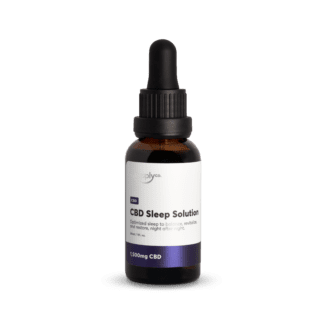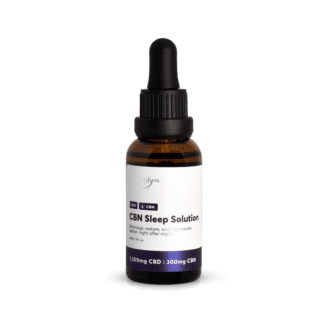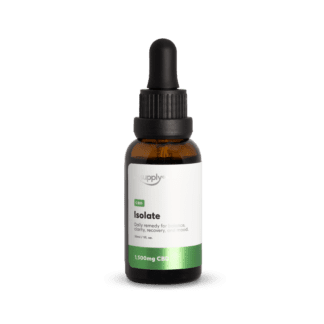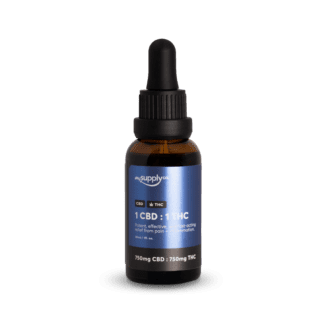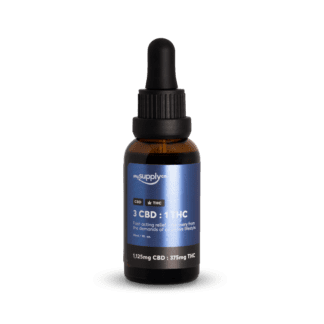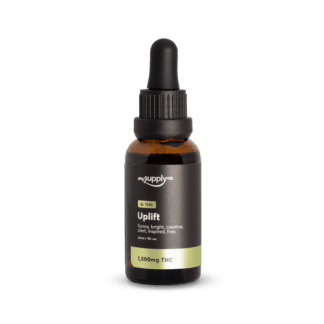If you suffer from chronic pain — that is, debilitating pain that lasts for three months or more — you’re not alone. More than 25 percent of Canadians are affected by it at any given time.
Chronic pain is commonly met with opiate prescriptions, leading to the overprescription and overmedication of society and a veritable opioid epidemic that is impacting our communities, healthcare system, social workers, and economy.
Over the last two decades, scientists on the search for natural, safe, and well-tolerated alternatives to opiates have tested THC's and CBD’s efficacy as analgesics, or painkillers — and with promising results.
But this isn't news to those of us with access to cannabis products.
A staggering proportion of people who can access cannabis and are living with chronic pain are using it to find relief.
According to Project 21, Only 14.4% of those with chronic pain reported that they had not previously used cannabis, while nearly two-thirds (61.6%) reported that they were currently using cannabis to treat their pain. 86.3% of these, or 52.7% of all pain patients, reported that they were using it daily.
In fact, a new study published by the Annals of Internal Medicine found that high-THC products that also contained CBD were associated with improved pain symptoms.
These findings, which were gathered from 25 studies and 15,000 participants, may come as a surprise since CBD has been marketed as a miracle elixir for pain, anxiety, and a range of clinical conditions.
While many of those benefits are real, it’s not likely that the CBD lotion you picked up at the health food store will work for your chronic pain. And those 2mg of CBD in your drink won't do squat.
Benefits occur from at least 50mg (milligrams) of full-spectrum CBD taken twice per day (more CBD isolate is needed for similar effects), and for many of the pain conditions we're treating, you would need at least 100 milligrams.
Here’s what we know so far about how we can use THC oil and CBD oil for pain relief.
How do THC and CBD relieve pain?
We've been studying the effect that cannabis has on pain receptors and the nervous system, and frequently recommend cannabis to clients experiencing chronic pain. Based on your type of pain, we would recommend higher CBD-to-THC formulation, or vice versa.
That said, most pain conditions are best relieved from some combination of the two ingredients. That's because CBD and THC work synergistically, which we go into depth about in another article.
If you have neuropathic pain, you'll typically respond better to a higher THC, or delta-9-tetrahydrocannabinol, ratio.
That’s because THC binds to the body’s natural cannabinoid receptors within the nervous system and brain. These receptors modulate a number of important signals in our body, including pain and our perception of pain, including its severity.
However, if you're dealing with inflammatory pain caused by conditions like inflammatory bowel disease (IBD) or rheumatoid arthritis, a formulation with a higher CBD, or cannabidiol, ratio is beneficial.
CBD has been found to help alleviate localized pain for brief periods of time.
That's because CBD activates various immune cell types and promotes the production of regulatory cells that can inhibit inflammation and control other immune cell targets. It also lightly "touches" a number of other systems, such as your endocannabinoid system, serotonin (5-HT) system, and TRPV-1 ion channels, to provide its numerous benefits.
The Annals of Internal Medicine also found that THC can help in coping with pain by creating a sense of euphoria.
Mood and disposition also improve with THC. Because chronic pain patients are complicated in that they have a bundling of symptoms, often combined with mental health symptoms, the mood component is a huge part of treating chronic pain.
CBD vs. THC for pain.
Cannabinoids like CBD and THC interact with a number of systems and receptors in our body, including the endocannabinoid system, which plays a role in signaling bodily functions, from emotional responses to motor control to energy balance.
For now, no CBD-based medications are approved as painkillers in Canada.
Epidiolex®, which is used for rare forms of epilepsy, is the only CBD treatment approved by the Food and Drug Administration (FDA). However, at the time of writing, Epidiolex® has not received a Notice of Compliance from Health Canada and is not marketed in Canada.
Meanwhile, Canada has approved Nabiximols (Sativex), a 1:1 ratio of CBD:THC, for symptomatic relief of pain in advanced cancer and multiple sclerosis.
Ongoing research suggests CBD oil for pain can aid medical conditions, including arthritis and fibromyalgia, at varying doses. Some pain may not be treatable by CBD alone, but it can help when paired with THC or Western medication applications, as CBD does have synergistic benefits when combined with certain medications. Just make sure you speak to a healthcare professional before pairing CBD with your current pain medications to avoid any potential interactions.
Interestingly, 60% of adults who use CBD products do so for its potential pain-relieving effects, according to a recent Forbes Health survey.

According to Consumer Reports, 40% of young adults (18 - 29 years old) in Canada have tried CBD, compared to 15% of older adults (65 years+).
CBD vs. THC for chronic pain.
Chronic pain is defined as any pain lasting longer than several months. Studies have found CBD, often alongside THC, to be an effective pain reliever for various chronic conditions.
In clinical trials, Sativex, a spray with equal parts CBD and THC, proved significantly successful as an analgesic for cancer-related pain. The spray, also used for multiple sclerosis-related pain, is approved in Canada to treat cancer pain and is currently undergoing trials for approval and use in the U.S.
A 2019 study found Sativex to be an “effective and well-tolerated add-on treatment” for patients with severe chronic pain stemming from various ailments. The study identified three types of pain: nociceptive (affecting body tissue), neuropathic (affecting nerves), and nociplastic (central sensitisation, e.g. fibromyalgia).
Sativex helped treat all three kinds but proved especially effective against neuropathic pain.
A preliminary controlled study also found CBD to be effective in chronic pain relief for conditions like multiple sclerosis and spinal cord injury, although across a much smaller sample size.
This is likely due to CBD's ability to protect, nourish, and regenerate different cells and protective components in our nervous system, which we get into later in the article.
CBD vs THC. for arthritis and joint pain.
Arthritis is a broad term that encompasses hundreds of joint-related conditions and pains. Common symptoms include swelling, pain, and stiffness in the joints which may progress over time.
Already a proven analgesic for other conditions, CBD shows promise as an anti-inflammatory substance in both animal and preclinical trials, which bodes well for treating arthritis caused by inflammation. However, clinical research dedicated to CBD administration for arthritis is less robust and ongoing.
Preliminary clinical data from a 2022 study on osteoarthritis suggests that, on its own, CBD did not significantly reduce pain intensity in patients. However, this study was underpowered; researchers only administered 20–30mg of a synthetic form of CBD daily. Instead, tackling chronic pain requires doses of at least 50–100mg of full-spectrum CBD, taken twice daily.
On the other hand, a 2018 study tested the efficacy of topical CBD gel on participants with osteoarthritis-related knee pain over the course of 12 weeks. Participants used either 250 milligrams or 500 milligrams, split into two applications, daily.
Overall, participants’ weekly pain levels didn’t improve much with CBD compared to placebo. Like the study above, we believe this is due to the use of a synthetic form of CBD, rather than a full-spectrum extract. However, when researchers evaluated the average weekly worst pain scores and Western Ontario and McMaster Universities Arthritis Index (WOMAC) physical function scores, participants who applied 250 milligrams of CBD daily experienced significant improvement over placebo participants.
The first controlled trial conducted in 2006 focused on patients with rheumatoid arthritis, an autoimmune disease that causes inflammation in the joints and other affected areas. Researchers found that, compared to a placebo, Sativex significantly improved participants’ pain during movement, pain at rest and quality of sleep. Any adverse reactions to the treatment were mild or moderate, and there were no complications with withdrawal.
Meanwhile, a 2019 trial suggests that a mix of CBD and THC may prove beneficial for people with fibromyalgia, a type of nociplastic pain condition that's caused by hyper-responsiveness and sensitivity that results in whole-body pain and fatigue. The study found that via a single inhalation, a CBD:THC solution performed better than a placebo and either substance on their own.
Fibromyalgia is not caused by inflammation but frequently co-occurs with different types of arthritis.
So what's the verdict on CBD vs. THC for arthritis and joint pain?
If nerve pain dominates your arthritis, use a higher ratio of THC-to-CBD. We offer 3 CBD : 1 THC and 1 CBD : 1 THC formulations using clinical-grade actives to suit your needs.
Speaking of nerve pain...
CBD vs. THC for neuropathic (nerve) pain.
Various conditions and injuries that damage nerves or the nervous system can result in neuropathic pain. This kind of pain manifests as tingling, numbness, muscle weakness, and a sharp, shooting, burning, or stabbing pain.
Multiple sclerosis (MS) is a common cause of neuropathic pain. The disease wears down myelin, a mixture of proteins and phospholipids that coats nerve cells.
Sativex is already approved as an MS treatment around the world due to its success in clinical trials.
As a spray, Sativex is absorbed in the mouth. Studies support a median dose of eight sprays a day for patients with MS, which provides about 20 milligrams of CBD and 21.6 milligrams of THC. However, doses vary between patients, and each person needs to find their optimal dose.
But that's not all.
Evidence suggests that CBD alone or combined with THC may offer protective and regenerative effects after nerve injury. That's because CBD activates certain pathways that are associated with neuronal protection and remyelination. Further research is warranted, but this could potentially offer a novel treatment to reverse the effects of demyelinating diseases like MS.
Let's take a look at the research.
A 2020 study tested topically administered CBD oil as a treatment for patients with peripheral neuropathy, or damage to the peripheral nervous system, which sends information throughout your body from the central nervous system. When compared to placebo, the topical CBD significantly reduced patients’ intense pain and sharp pain, as well as cold and itchy sensations.
When it comes to THC, a 2008 double-blind, placebo-controlled study found that smoking low-THC flower (3.5% THC) was just as effective as smoking higher THC doses (7% THC). However, at the high dose, some participants experienced neurocognitive impairment in attention, learning, memory, and psychomotor speed. Only learning and memory declined at the low dose.
In 2010, a randomized crossover trial on patients with posttraumatic or postsurgical neuropathic pain tested different THC doses on mood, sleep, quality of life, and adverse effects. Patients in the 9.4% THC group reported significantly less pain and better sleep.
The downside?
While THC is superior in addressing neuropathic pain conditions, too much THC impairs important everyday functions, reducing the ability to perform activities of daily living, such as driving.
Ultimately, you'll want to address neuropathic pain with a CBD formulation that's also rich in THC.
Research on neuropathic pain and demyelinating disorders like multiple sclerosis shows that CBD and THC can not only help suppress the pain, but exert protective and regenerative benefits.
Should I use CBD or THC for my pain condition?
It all comes down to the type of pain you're experiencing.
Take CBD if you're addressing pain conditions that are primarily caused by inflammation or autoimmune disorders, such as rheumatoid arthritis.
This includes inflammatory bowel disease (IBD), Crohn's disease, Parkinson's pain, herniated discs, tension headaches, and migraines.
That's because CBD addresses inflammation and autoimmune disorders in three ways:
- firstly it elevates your body's production of natural cannabinoids, boosting its anti-inflammatory and pain responses;
- secondly, CBD modulates your CB2 receptors — part of the body’s immune system — which play a role in reducing pain and inflammation; and
- finally, CBD acts on cytokine molecules, produced by our immune cells, reducing the levels of pro-inflammatory cytokines while simultaneously boosting the levels of anti-inflammatory cytokines. Unlike non-steroidal anti-inflammatory drugs (NSAIDs), CBD comes with very few side-effects and is safe enough to use on a regular, or even daily, basis.
You can use our CBD Dosage Calculator to find the best introductory dose for your type of pain or inflammatory condition.
Include THC in your regimen if you're experiencing pain conditions that are primarily neuropathic in nature.
This includes Parkinson's pain, MS pain, spinal cord injury, neuralgia, chronic headaches, and peripheral neuropathy.
That's because THC modulates your CB1 receptors, which are heavily dispersed throughout our brain and nervous system, and regulate processes involved in pain and pain perception.
But remember:
When dealing with neuropathic pain conditions, we highly recommend a CBD-rich formula, as CBD confers neuroprotective and neurodegenerative benefits that complement THC's pain-killing effects in the long run.
Lastly, take a ratio of 1 CBD : 1 THC for addressing nociplastic pain conditions, such as fibromyalgia, IBS, pelvic pain syndrome, musculoskeletal pain, and chronic migraines.
Do CBD and THC have side effects?
Both we and The Annals of Internal Medicine study agree that precautions do need to be taken — for example, taking too much THC can lead to dizziness and sedation.
If you experience these effects, simply lower the dose. If you feel you’ve taken too much THC, you can also counteract it with a dose of CBD, which cancels out the former’s psychoactive effects. However, too much CBD can cause abnormalities in the liver and negatively interact with blood thinners and other medications.
Other potential side effects of THC include confusion, dry mouth, upset stomach, and vertigo, but all can be managed by lowering your dose.
However, we’re talking about mild, reversible effects with cannabis compared to opiates.
Is there a correct CBD-to-THC ratio?
The ratio depends on the condition.
We recommend a balanced ratio of 1:1 CBD:THC for moderate to severe pain conditions, as well as conditions that affect the nervous system. We recommend a more CBD-rich ratio, such as 3:1 CBD:THC, for mild to moderate pain conditions, as well as inflammatory and autoimmune conditions. If you find that you're sensitive to THC, we recommend full-spectrum CBD.
Note that, as with all medicines, your body is unique and there is no "one-size-fits-all." What works for one person may not work for you, so start low and adjust your dose as needed.
Check out our Quick Guide to Finding Your Ideal CBD:THC Ratio for more info on how to pick a ratio
What's the best way to take cannabis for pain?
The effects of edibles last for six to seven hours, inhalation lasts about three hours, and sublingual liquid lasts four to five.
Topicals, tinctures, and edibles can be taken two to three times per day, while inhalation can be dosed every three hours if there aren’t pre-existing respiratory issues.
It’s also important to remember that while cannabis has been a medicinal plant used by humans for generations, the long-term effects of use are still being studied. Findings suggest that medical professionals need to carefully evaluate the potential benefits and drawbacks of using THC to treat chronic pain.
Our advice?
Take claims about cannabis that are coming from commercial sources with a grain of salt, take guidance from a cannabis professional, create realistic expectations about the medicine, and be patient.e
